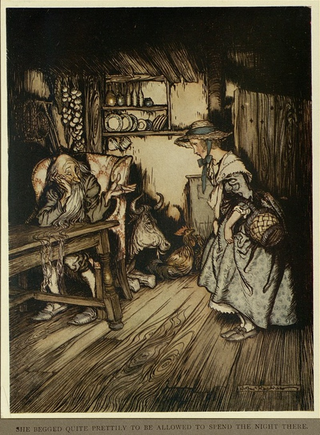Related Research Articles
The Red Ettin or The Red Etin is a fairy tale collected by Joseph Jacobs. It was included by Andrew Lang in The Blue Fairy Book.

"The Hut in the Forest" is a German fairy tale collected by the Brothers Grimm. Andrew Lang included it in The Pink Fairy Book (1897). It is Aarne-Thompson type 431.
The Blue Mountains is a fairy tale. Andrew Lang included it in The Yellow Fairy Book (1894), but provided no bibliographical information and its origin remains obscure.

The Battle of the Birds is a Scottish fairy tale collected by John Francis Campbell in his Popular Tales of the West Highlands. He recorded it in 1859 from a fisherman near Inverary, John Mackenzie and was, at the time, building dykes on the Ardkinglas estate.

"The Witch in the Stone Boat" is an Icelandic folktale, originally collected by Jón Árnason (1864), translated into English in Andrew Lang's fairy tale collection The Yellow Fairy Book (1894).
Asmund and Signy is an Icelandic fairy tale published by Scandinavist Josef Calasanz Poestion in Islandische Märchen. Andrew Lang included it in The Brown Fairy Book.
Molly Whuppie is an English language fairy tale set in Scotland. It was first published in 'Three Folk-Tales from Old Meldrum, Aberdeenshire' in "Folklore" (6.2.1884). Rev. Walter Gregor said that the tales had been 'communicated to me by Mr. Moir, Rector of the Grammar School, Aberdeen. He had them from his mother, who kindly wrote out " Mally Whuppie " and " The Red Calf" at my request.' Anglicising the name to "Molly" from "Mally" Joseph Jacobs used this source of the story in his English Fairy Tales. A Highland version, Maol a Chliobain, was collected by John Francis Campbell in Popular Tales of the West Highlands. Jacobs noted the relationship between the two tales, and an Irish variant, "Smallhead," and concluded that the tale was Celtic in origin.

The Sea-Maiden is a Scottish fairy tale collected by John Francis Campbell in Popular Tales of the West Highlands, listing his informant as John Mackenzie, fisherman, near Inverary. Joseph Jacobs included it in Celtic Fairy Tales.
The Daughter of the Skies is a Scottish fairy tale collected by John Francis Campbell in Popular Tales of the West Highlands, listing his informant as James MacLauchlan, a servant from Islay.
"The Brown Bear of the Green Glen" is a Scottish fairy tale collected by John Francis Campbell in Popular Tales of the West Highlands, listing his informant as John MacDonald, a "Traveling Tinker". He also noted the parallels with The Water of Life.

The King of England and his Three Sons is a Romani fairy tale collected by Joseph Jacobs in More English Fairy Tales. He listed as his source Francis Hindes Groome's In Gypsy Tents, where the informant was John Roberts, a Welsh Roma. Groome published the tale as An Old King and his three Sons in England.
Jack and His Golden Snuff-Box is a Romani fairy tale collected by Joseph Jacobs in English Fairy Tales. He listed as his source Francis Hindes Groome's In Gypsy Tents.
"The Bold Knight, the Apples of Youth, and the Water of Life" is a Russian fairy tale collected by Alexander Afanasyev in Narodnye russkie skazki. The tale and is variants are numbered 171-178 in the first volume of the three-volume collection.
"The Thirteenth Son of the King of Erin" is an Irish fairy tale collected by Jeremiah Curtin in Myths and Folk-lore of Ireland.
The Three Daughters of King O'Hara is an Irish fairy tale collected by Jeremiah Curtin in Myths and Folk-lore of Ireland. Reidar Th. Christiansen identified its origin as County Kerry.

The Greek Princess and the Young Gardener is an Irish fairy tale collected by Patrick Kennedy in Fireside Stories of Ireland. Joseph Jacobs included it in More Celtic Fairy Tales.

The Norka is a Russian and Ukrainian fairy tale published by Alexander Afanasyev in his collection of Russian Fairy Tales, numbered 132.
"The Griffin" is a German fairy tale collected by the Brothers Grimm in Grimm's Fairy Tales.

"The King of the Golden Mountain" is a German fairy tale collected by the Brothers Grimm in Grimm's Fairy Tales.

Adventures of Gilla Na Chreck An Gour is an Irish fairy tale collected by folklorist Patrick Kennedy and published in Legendary Fictions of the Irish Celts (1866). The tale was also published by Irish poet Alfred Perceval Graves in his Irish Fairy Book (1909). Joseph Jacobs published the tale as The Lad with the Goat-Skin in his Celtic Fairy Tales.
References
- ↑ Glover, W. J; Folkard, Charles. British fairy and folk tales . London: A. & C. Black, 1920. pp. 269-280.
- ↑ Campbell, J. F. (1860). Popular Tales of the West Highlands . Vol. I. Edmonston and Douglas. pp. 244-252 (English translation), 252-257 (Scottish Gaelic text).
- ↑ Aarne, Antti; Thompson, Stith. The types of the folktale: a classification and bibliography. Folklore Fellows Communications FFC no. 184. Helsinki: Academia Scientiarum Fennica, 1961. pp. 90-93.
- ↑ Annus, Amar & Sarv, Mari. "The Ball Game Motif in the Gilgamesh Tradition and International Folklore". In: Mesopotamia in the Ancient World: Impact, Continuities, Parallels. Proceedings of the Seventh Symposium of the Melammu Project Held in Obergurgl, Austria, November 4-8, 2013. Münster: Ugarit-Verlag - Buch- und Medienhandel GmbH. 2015. pp. 289-290. ISBN 978-3-86835-128-6.
- ↑ Ó Súilleabháin, Seán. Folktales of Ireland. Chicago: University of Chicago Press, 1968. p. 290.